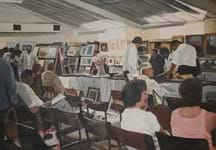How refreshing, then, to read that Louise Gostelow of Dickins Auctioneers wishes to get back to our industry’s core values, despite the challenges of Brexit, GDPR and so on. I would like to add to her reference to a passion for handling art and antiques with a song of praise for so-called ‘brown furniture’ and an exhortation for the industry to make this stalwart of the chattels world a priority for 2019.
The fall in demand for antique furniture over the past 10-15 years is partly the result of how ‘fast furniture’ has been sold through heavy marketing. This advertising extols flatpack furniture for its look, availability and price.
Yet antique furniture has some tremendous and obvious plus points over the modern equivalent. It has a low carbon footprint, with a long shelf life and doesn’t require assembling.
It is also, pro-rata, much cheaper than its modern equivalent. A three-drawer chest at IKEA is currently £115. Meanwhile, a small Victorian painted pine chest of two short and two long drawers recently sold at a Cotswold auction house for £50! No need to answer the question: which one will last longer?
The relative prices of antique furniture and the modern equivalent have now reached parity and the longevity of the antique needs to be marketed more strongly.
To the trade: surely now is the time to stress the sustainability, aesthetics, good value and sheer joy of ‘slow furniture’ rather than let this area of the market fade from view?
Please can the industry at large add this mission to their resolutions.
Jeremy Lamond
Fine art director, Halls
What about the younger generation?
MADAM – Among the resolutions cited by your correspondents, it was noticeable that there was little mention of raising the younger generation’s interest in the world of antiques and fine art.
After all, we must hope they will be the buyers of the future.
At present, they probably relate the word ‘antiques’ to unappealing Victorian brown furniture.
For a recent talk I gave to a sixth-form class at a well-known public school, I took along examples of Sèvres porcelain that were closely connected with Louis XVI and Emperor Napoleon.
I seemed to have had a receptive audience, judging from the lively questions afterwards.
John Hudson
Retired – formerly of Christie’s
A spirited sector
MADAM – I was both amused and heartened by many of the comments made in ‘New year, new resolutions’. Despite the continual adversity of ill-judged legislation and potential Brexit mayhem we are – as an industry – doers.
Throughout my 30 years in the business I have always been invigorated and inspired by our general ability to re-invent and cope with major fluctuations in the art and antiques sector. It has changed immeasurably in that time but at its core is the premise that Louise Gostelow raises about ‘a true passion for what we do’. This is what drives and motivates many of us because you simply can’t kill that spirit.
It’s this – in my mind – that is the true foundation of our business ethos. However, we may deal in history but this does not mean that we are backward looking!
So, whether we’re faced with mountains of extra paperwork or forced to find a work-around in the form of antique barrels (thank you Mr Baggott), I’m sure we will rise above the thoroughly depressing mood that seems to pervade everything in general to emerge – as we always do – as a strong, energetic and pragmatic force that continues to play a major part in the economy of this country and on the world stage.
Here’s to mining those trends, creating new markets and rising to the challenges that are constantly thrown at us by maintaining a forceful and cohesive lobbying entity.
And thank you ATG, for being our platform for all of this.
Marc Allum
Consultant to Duke’s Auctioneers and BBC Antiques Roadshow specialist












